The Evolution of Plastic Model Kits: From Simple to Complex
The Evolution of Plastic Model Kits: From Simple to Complex
Blog Article
Plastic Model Kit Reviews: What’s Hot in the Hobby World
Plastic model kits have undergone a significant change since their inception, evolving from simple and simple patterns to highly detail by detail and delicate representations of real-world subjects. That advancement shows innovations in materials, production methods, and the growing style of modelers' expectations. In this information, we examine the development of model kits, from their humble beginnings to the complex systems available today.

Early Beginnings: Simple Models and Standard Kits
The history of plastic model kits dates back again to the first 20th century, with the initial commercially available sets emerging in the 1930s. Originally, these designs were easy and directed mostly at children. Early products, made from standard plastic materials, were built to be snapped together, providing a simple release to modeling for small hobbyists. These versions generally highlighted small depth and were usually created in one or two shades, with few options for customization.
Development in Reputation: The 1950s and 1960s
As plastic turned more commonly available, the 1950s and 1960s saw an important change in the difficulty and number of model kits.In this period, makers began introducing more descriptive sets, targeting adult fanatics along with children. Aircraft, cars, and boats were frequent subjects, and kits began to include numerous components for added realism. But, designs however depended on fundamental assembly methods, with several options for painting and finishing.
Developments in Engineering: The 1970s and 1980s
The 1970s and 1980s noted a turning stage on earth of plastic modeling. Innovations in mold-making engineering permitted for more in depth areas and greater features. This time also found the release of replacement accessories, such as for example photo-etched components, to improve the reality of models. Modelers started experimenting with different painting practices, weathering outcomes, and detailing, leading to more individualized and lifelike creations. That age also found the rise of very specialized packages, such as military tanks and dioramas, which appealed to enthusiasts with unique interests.

The Modern Period: Highly Comprehensive and Complicated Sets
Today, plastic model kits reach new quantities of sophistication. Makers today make models which are amazingly comprehensive, with hundreds of specific parts made to reproduce real-world items with remarkable accuracy. Electronic modeling and 3D making have revolutionized the style method, allowing for greater accuracy and elaborate explaining that was once unimaginable. Contemporary sets feature sophisticated components such as for instance movable components, highly step by step decorations, and practical floor textures. Furthermore, many sets come with comprehensive training guides and decals, enabling modelers to generate very exact replicas.
From easy snap-together sets to very step-by-step projects, the development of plastic model kits reflects the growing expertise and creativity of modelers, in addition to the ongoing invention in manufacturing and design. Whether you're a beginner or an experienced enthusiast, there's never been an improved time and energy to explore the planet of plastic modeling. Report this page